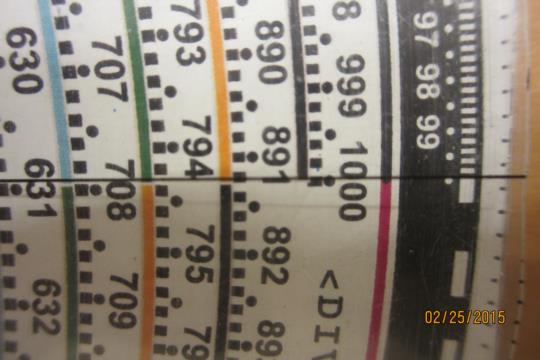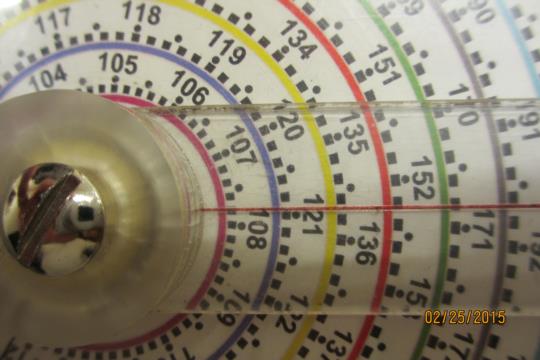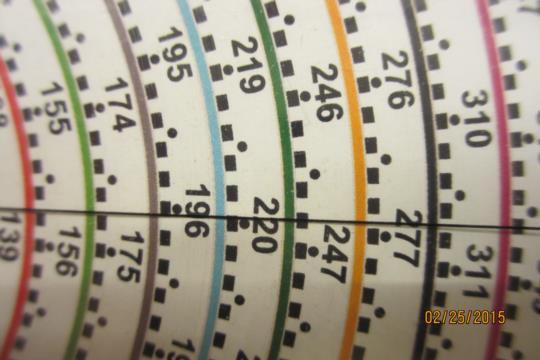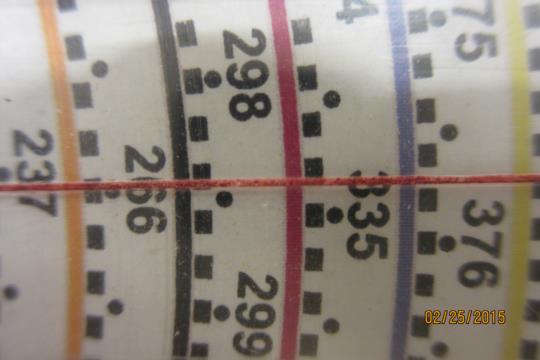
NavList:
A Community Devoted to the Preservation and Practice of Celestial Navigation and Other Methods of Traditional Wayfinding
Re: 4-digit Circular Sliderules
From: Hanno Ix
Date: 2015 Feb 25, 21:06 -0800
__________________________________________________
From: Hanno Ix
Date: 2015 Feb 25, 21:06 -0800
Greg -
and all others interested in 4-digit slide rules:
Yes, you will be able to make the SCALE1/2 into 8"-diam ones.and all others interested in 4-digit slide rules:
__________________________________________________
2. Usage, part 1
There is one particular feature on circular slide rules: pointers that can be moved individually and as a pair. On my designs one pointers is a black line scratched in to a transparent plastic disk covering the entire scale, whereas the other is a red line scratched into an 1" wide transparent plastic strip. Both lines extend from the center to the rim and both turn with one of their ends around the center.
Move the black pointer by turning the disk with the thumb as you hold the slide rule with both hands. Notice that the red pointer moves simultaneously so that both move as a pair but some, for now arbitrary, angle apart.
When you move the red pointer the black pointer/disk must stay fixed. So you will just hold the slide rule in one hand, and squeeze the disk down to the scale with the thumb while you move the red pointer with a finger of the other hand.
Today, I will describe the simplest usage: confirming a multiplication performed otherwise before. Please follow me going through the 4 steps as pictured in the attached pictures.
Today, I will describe the simplest usage: confirming a multiplication performed otherwise before. Please follow me going through the 4 steps as pictured in the attached pictures.
Example:
A= 1357; B= 2468; find A*B;
A= 1357; B= 2468; find A*B;
Preliminary calculation yielded 3346
Check this with the slide rule.
Step I: set the black pointer to 1000. Again the red pointer will move with it, for now at some random angle apart.Step II: Fix the disk, move the red pointer to factor A, 1357. This will establish and angle between both pointers - a measure of log(A).
Step III. Release the disk and move it until the black pointer hovers over the factor B, 2468. As you do that the red pointer will moves along. But make sure the angle between both pointers established in Step II will not get disturbed while both pointers move during Step III.
Step IV: Read the result under the red pointer. Well, there are many locations where you could read a "result". But if your original multiplication, the one you wish to check, was not gravely wrong then one of these numbers will be very close or the prior result. I read 3349, and that is the correct result. You could be forgiven if you read 3348.
While both results are rather close as a matter of course I'd go back anyway and analyze the original calculation so that I have an idea what caused this difference.
And no, I did not cheat - I did exactly as I described here, not more, not less. This accuracy is in fact typical when you use these slide rules.
So much today.
H
On Mon, Feb 23, 2015 at 5:11 AM, Greg Rudzinski <NoReply_Rudzinski@fer3.com> wrote:
Hanno,
Based on the Atlas description it can perform to 5 places. Looking closer at the scales has me thinking 4 places. The outer scale of the Atlas gives results to 2 or 3 places and is used to aid in selecting the correct spiral. A project on the horizon will be to fit an 8 inch print of your scales onto the face of a basic 8 inch circular slide rule for trials.
G
From: Hanno Ix
Date: 2015 Feb 22, 19:46 -0800My goal has been creating a Circular Slide Rule capable of just 4 - digit multiplications/divisions usable for CelNav and designed such that it can be build by a dedicated hobbyist with good but modest tools.Hello,this ATLAS seems in many ways more complex but also more powerful.
I cannot make out from the picture if ATLAS's long scale is a spiral but the text in Greg's link appears to be saying so. My SCALE1 may be used as described there, I believe. My color schemes, though, are additional tools for estimating more quickly on which turns of the spiral the factors and the result may be found. I suppose the yellow background of some turns on the ATLAS is meant for the same purpose - I would like to know more about that. Without such a tool it takes quite long to locate the numbers. Perhaps you can find a particular clever method - better than ATLAS or me.
I owe you still a detailed description of using my designs - I ask you for your patience, though. However, I can see from your notes you might already be researching your own ideas of using them. Great!
H










